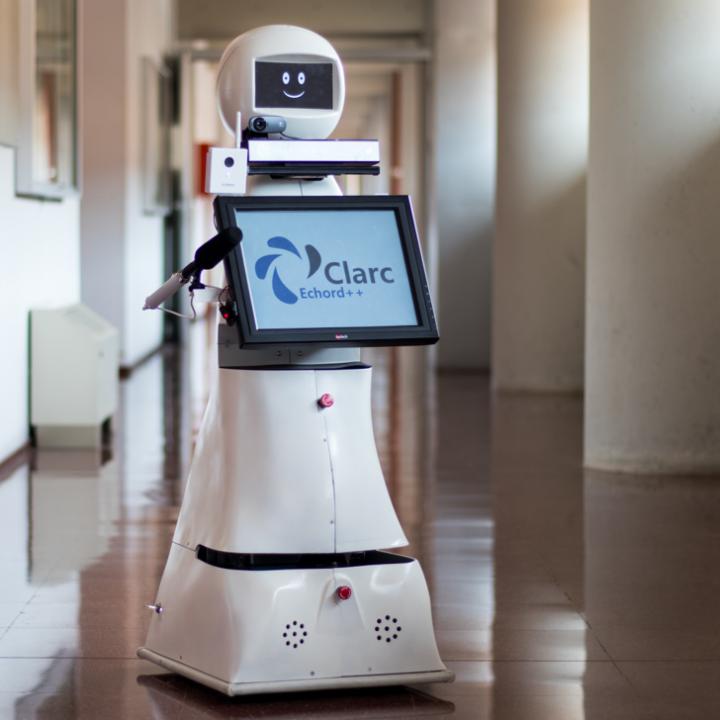It is designed to facilitate the work of professionals in nursing homes and hospitals

Credit: University of Malaga
Researchers of the Integrated Systems Engineering Group of the University of Malaga (UMA) have designed a telepresence robot that enables people suffering from COVID-19 to talk to their loved ones.
Although this scientific team has been working in social robotics for more than a decade within the ROSI project, they have provided this new design with additional functions in order to adapt it to the pandemic needs, with the aim of facilitating the work of professionals in nursing homes and hospitals.
“We have enabled people that are isolated in a room to have a video call with relatives and friends without risks and regardless of their ability to use new technologies”, says one of the main researchers of this project, Juan Pedro Bandera, Professor of the School of Telecommunications.
The researcher explains that the procedure would be as follows: a friend or relative books an hour for a video call by using a simple web interface; the robot boots up autonomously and goes to the counter to be disinfected, according to protocol; then, it goes to the room and starts the video call at the scheduled time; when finished, it is disinfected again and then goes to its resting place.
Just over a meter high, with a cylindrical or pedestal-shaped body, this “made in UMA” robot has simple expressive abilities, audiovisual communication capacity and, moreover, it is able to move around autonomously in daily life scenarios.
This way, announcing daily events in common areas of nursing homes like a “town crier” or offering the elderly the possibility of fulfilling themselves, sharing and viewing photos are other functions of this robot.
Effective and socially accepted device
“A social robot that crosses continuously between two people talking, that gets too close to them when moving around, that moves too fast or abruptly or stops in a corridor blocking their way will not be accepted and, therefore, will not be useful”, says Juan Pedro Bandera Rubio, coordinator of the project.
Based on this approach, the researchers have also conducted two experiments related to social navigation within this project. In the first one, they have studied energy consumption in a real robot that moves around by following trajectories with different smoothness factors, since smoothness is one of the parameters most commonly used to describe the movement of a robot. In the second experiment, they have analyzed opinions and impressions collected from different participants after presenting simulated situations where a robot moves around certain virtual scenarios, applying, again, trajectories with different smoothness factors.
The results of these experiments show that, in general terms, smoother paths decrease energy consumption and increase social acceptability. However, they also show that other critical factors need to be considered, such as keeping an adequate distance from people: “Most likely a social robot should not try to move around like humans do. The robot will have to keep greater distance and avoid abrupt turns and speed changes in a stricter way, as well as erratic trajectories which destination is difficult to predict, because all these aspects, although satisfying the safety, efficiency and smoothness conditions, will reduce the acceptance of the robot considerably”, points out Bandera Rubio.
So far, the pandemic has not enabled the arrival of the robots at nursing homes and hospitals, but successful pilot studies have been carried out. Moreover, the European transfer project “DIH-HERO”, focused on the use of these assistant social robots to have video calls and based on the work conducted within the ROSI project, has just started and, in the coming months, it will enable the deployment of robots in these shared spaces.
Apart from the Integrated Systems Engineering Group, this project has also been conducted by the Department of Computer Science and Programming Languages of the UMA, the University Carlos III of Madrid, the University of Jaen, the University of Troyes (France) and the Virgen del Rocío University Hospital in Seville. It is financed by the Department of Economy, Knowledge, Business and University of the Government of Andalusia.
###
Bibliography:
Guillén Ruiz, S.; Calderita, L.V.; Hidalgo-Paniagua, A.; Bandera Rubio, J.P. Measuring Smoothness as a Factor for Efficient and Socially Accepted Robot Motion. Sensors 2020, 20, 6822. https:/
Media Contact
María Guerrero
[email protected]
Original Source
https:/




